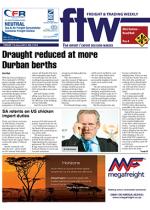With the Transnet National
Ports Authority’s (TNPA’s)
plans to dredge a number of
silted-up berths at the Port
of Durban having proved
unworkable, the authority has
now had to declare reduced
permissible draughts at three
more container berths.
According to TNPA, SA
ports are supposed to have
on-going maintenance
programmes of dredging to
remove silt deposited by rivers
that compromise port depth,
to remove high and low spots
resulting from propulsion wash
(also termed ‘scouring’) during
the movement of ships, and to
counter the effect of littoral
drift or long-shore movement
of sand.
But with Durban berths
silting up as they have just
done, doubt has to be cast on
the efficiency of the dredging
services timetable.
And this recent TNPA
emergency dredging plan has
just failed.
“The intervention to
expedite removal of high spots
from affected berths using
a combination of the TNPA
dredger Isandlwana and an
outsourced dredger from
Subtech, was not satisfactory,”
said TNPA’s Durban harbour
master Captain Alex Miya in
a letter to the SA Association
of Ship Operators and Agents
(Saasoa).
The Subtech dredger using
airlift proved ineffective, and
the 12.8 metre depth (most
recently allowing ships a
permissible draught of 12.2m)
could not be achieved, he
added.
The new action plan was for
Subtech to submit a further
dredging proposal last week;
dredging services to get its TT
and DOP pumps operational;
and the grab/hopper dredger
Italeni to be back in Durban in
two weeks’ time.
But the situation has now
become critical for the
shipping lines. There are now
six container berths (105, 107,
108, 200, 204 and 205) all
working with reduced drafts
– of 11.7m in four cases (105,
107, 200 and 204) 11.6m in
one (108) and 11.9m in one
(205).
This is compared to all
their original permissible
draughts of 12.5m – reduced
earlier this year to 12.2m
in a knee-jerk reaction by
TNPA to three ships having
grounded at the port (one at a
berth) in the last year.
And all this means vessels
– and they’re all becoming
bigger nowadays thanks to
the cascading of ships from
their original deployment
on the three main east-west
trades – having to sail light
loaded. In a quick thumb
suck, a shipping line executive
told FTW that this meant
short shipping at the very
least 1 000 TEU containers
(twenty-foot equivalent units)
every trip to Durban (500 off
and 500 on).
And that’s a vast amount of
money down the drain.
FTW spoke to Peter
Besnard, CEO of Saasoa,
about this matter.
And, he told FTW, the lines
were anything but happy
about this unsatisfactory and
costly scenario.
“They (TNPA) took on
some big vessels and they
publicised it all over the
show,” Besnard said. “So all
we want is to get back to those
original permissible draughts
as quickly as possible
“But I’m sorry to say that
there are just too many
meetings and they’re just not
getting down to the job at
hand.”
Saasoa, he added, keeps
hearing stories like they
don’t have the dredgers,
or that they can’t get a
good run at dredging the
berths, especially 203-205,
because of continuous berth
occupancy.
“But everybody is saying:
‘Hire a dredger and do
it’. And, if we can’t get
accommodation for these
bigger vessels, we’ll just have
to do something about it.”
Besnard assured FTW
that, if the lines were given
sufficient notice and time
to replan their schedules, it
would be possible to leave
a berth vacant while the
TNPA was working on it.
“We have said we can do
it. It’s in the best interests of
the lines,” he added.
Draught reduced at more Durban berths
12 Jun 2015 - by Alan Peat
0 Comments
FTW - 12 Jun 15

12 Jun 2015
12 Jun 2015
12 Jun 2015
12 Jun 2015
12 Jun 2015
12 Jun 2015
12 Jun 2015
12 Jun 2015
12 Jun 2015
12 Jun 2015
12 Jun 2015
12 Jun 2015
Border Beat
17 Jun 2025
30 May 2025
Poll
Featured Jobs
New
New
